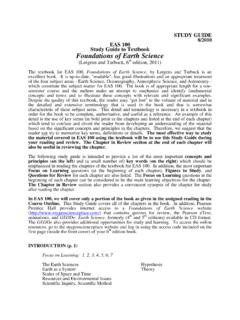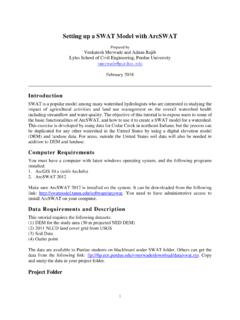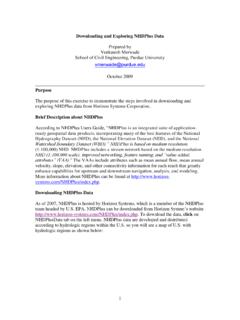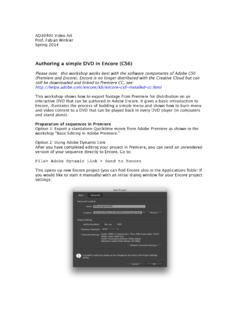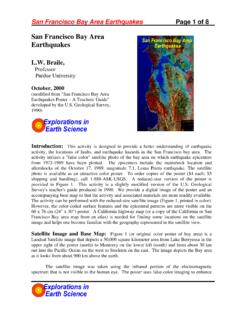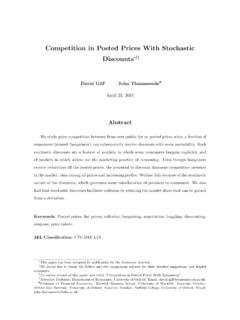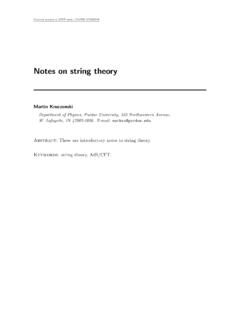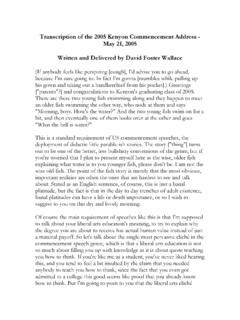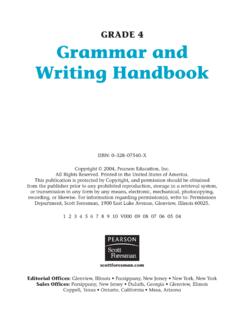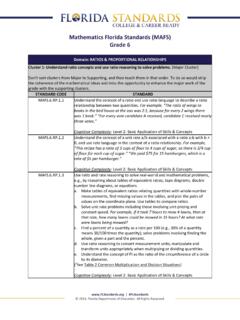Transcription of Steps for Solving Quadratic Story Problems
1 16-week Lesson 14 (8-week Lesson 10) Applications of Quadratic Equations 1 When Solving application Problems , it is helpful to have a procedure that you follow in order to solve the problem. The following are the Steps that I will use when Solving Applications of Quadratic Equations: Steps for Solving Quadratic Story Problems : 1. draw a picture 2. define unknown variables 3. set-up equations 4. solve Once again when Solving applied Problems I will include questions in my notes to help set-up equations. Keep in mind that the questions below in red will not appear in the homework, or on quizzes and exams; these are simply questions that you should be asking yourself when you see Problems like these in order to help get equations that you can solve. Also keep in mind the various methods that we ve covered thus far for Solving Quadratic equations: - solve by factoring (only works when polynomials are factorable) o write the equation as a polynomial set equal to zero, factor, use Zero Factor Theorem - solve by extracting square roots (only works with perfect squares) o isolate the perfect square and take the square root of both sides of the equation - solve by completing the square (works for all Quadratic equations) o divide by the leading coefficient, isolate the constant, add half the square of the coefficient of to both sides of the equation, factor, solve as a special Quadratic equation - solve using the Quadratic formula (works for all Quadratic equations) o identify , , , plug-in to the formula, simplify completely 16-week Lesson 14 (8-week Lesson 10) Applications of Quadratic Equations 2 Example 1.
2 A rock is thrown directly upward with an initial velocity of 96 feet per second from a cliff 200 feet above a beach. The height of the rock above the beach ( ) after seconds is given by the equation = 16 2+96 +200 a. When will the rock be 328 feet above the beach? 328= 16 2+96 +200 0= 16 2+96 128 b. When will the rock hit the beach? (round to the nearest hundredth of a second). When the rock is on the beach, what is the value of ? 0= 16 2+96 +200 = (96) (96)2 4( 16)(200)2( 16) 328 200 0 16= 16 2 16+96 16 128 16 0= 2 6 +8 0=( 2)( 4) = , 16-week Lesson 14 (8-week Lesson 10) Applications of Quadratic Equations 3 = (96) (96)2 4( 16)(200)2( 16) = 96 9216+12800 32 = 96 22016 32 = 96+ 22016 32 , 96 22016 32 = 96+ 32 , 96 32 = 96+ 32 , 96 32 = , Since is representing time (specifically, the time it takes the rock to hit the beach), it cannot be negative.
3 Therefore we will disregard the negative answer and keep only the positive answer. = The directions asked to round the answer to the nearest hundredth of a second, so that means we should round on the second digit to the right of the decimal point. = . 16-week Lesson 14 (8-week Lesson 10) Applications of Quadratic Equations 4 Example 2: A family plans to have the hardwood floors in their square dining room re-finished, and new baseboards installed. The cost of re-finishing the hardwood floors is $ per square foot and the cost of purchasing and installing the new baseboard is $ per linear foot. If the family paid $1,224, what are the dimensions their dining room (width and length)? Draw a diagram of the square dining room and labels the sides. (if you don t know the side length, assign a variable to represent this value) The floor represent the area of the room, so write an expression for the cost to re-finish the hardwood floors based on the area of the room.
4 The baseboard represent the perimeter of the room, so write an expression for the cost to install new baseboards based on the perimeter of the room. Write an equation for the total cost of the job, and use that equation to solve for your variable. + = 16-week Lesson 14 (8-week Lesson 10) Applications of Quadratic Equations 5 2+48 =1224 92 2+48 1224=0 2(92 2+48 1224)=(0)2 9 2+96 2448=0 = 2 4 2 = (96) (96)2 4(9)( 2448)2(9) = 96 9216+8812818 = 96 9734418 = 96 31218 = 96+31218 ; = 96 31218 =21618 ; = 40818 =12 ; = 683 Normally I try to solve Quadratic equations by factoring first, but since the coefficients are so large in this equation, and since there is no common factor to divide off or factor out, I m going to simply use the Quadratic formula. Since represents a dimension, it cannot be negative.
5 Therefore the width of the dining room is feet, and the length of the dining room is feet. 16-week Lesson 14 (8-week Lesson 10) Applications of Quadratic Equations 6 Example 3: A rectangular piece of sheet metal is 7 inches shorter than it is wide. From each corner, a 3 3 inch square is cut out and the flaps are then folded up to form an open box. If the volume of the box is 1620 3, find the length and width of the original piece of sheet metal. What is the width of the rectangular piece of sheet metal? (if you don t know, assign a variable to represent this value) What is the length of the rectangular piece of sheet metal? (remember that the length is 7 inches less than the width) Draw a diagram of the rectangular piece of sheet metal and list its dimensions. Then draw the 3 3 inch squares in each corner and the flaps, and list the dimensions of the box. Keep in mind that the width and length of the box will be LESS than the width and length of the sheet metal.
6 Write an equation for the total volume of the box, and use that equation to solve for your variable. = 16-week Lesson 14 (8-week Lesson 10) Applications of Quadratic Equations 7 ( 6)( 13)(3)=1620 ( 2 13 6 +78)3=1620 ( 2 13 6 +78)33=16203 2 19 +78=540 2 19 462=0 2+14 33 462=0 ( +14) 33( +14)=0 ( +14)( 33)=0 +14=0 ; 33=0 = 14 ; =33 = = = = Since = 14 is not possible (the width of a sheet of metal cannot be negative), we disregard that answer. Therefore =33 is the only possible answer for the width of the sheet of metal. And if the sheet of metal is 33 inches wide, then it is 33 7=26 inches long. The width of the sheet of metal is inches, and the length of the sheet of metal is inches. 16-week Lesson 14 (8-week Lesson 10) Applications of Quadratic Equations 8 Example 4: Two trains leave a station at 11:00am.
7 One train travels north at a rate of 45 mph and another travels east at a rate of 60 mph. Assuming they do not stop, at what time will the trains be 200 miles apart? Draw a diagram of the distances traveled by each train, and the distance between them. To convert a rate such as to just miles, simply multiply by some number of hours Since our diagram is a right triangle, we can use the Pythagorean Theorem to write an equation in terms of the length (distance) of each side. ( )2+( )2=( )2 45 mph 60 mph 200 miles (45mileshour)( hours) =45 miles 200 miles (60 mileshour)( hours) =60 miles 16-week Lesson 14 (8-week Lesson 10) Applications of Quadratic Equations 9 ( )2+( )2=( )2 (45 )2+(60 )2=2002 2025 2+3600 2=40,000 5,625 2=40,000 2=40,0005,625 2= = Since represents time (hours), it cannot be a negative value, so disregard the negative answer and keep only the positive answer.
8 = Since is in terms of hours, this represents 2 hours and of an hour. of an hour is less than 1 hour, so it might make more sense to think of this in terms of minutes. To convert a fraction (or decimal) of an hour to minutes I can multiply it by 60 (60 minutes in an hour) to get 40 minutes. So if both trains depart at 11:00am, both trains will be 200 miles apart 2 hours and 40 minutes later, or at 1:40pm. : Answers to Exercises: 1a. =2,4 ; 1b. = ; 2. 12 12 ; 3. 33 26 ; 4. 1:40.
